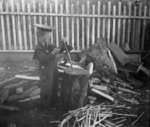Editor’s note: Tim Caldwell served as a founding board member of the Fort Worden Public Development Authority and currently works in Guest Services at the fort, a position that includes researching …
This item is available in full to subscribers.
We have recently launched a new and improved website. To continue reading, you will need to either log into your subscriber account, or purchase a new subscription.
If you had an active account on our previous website, then you have an account here. Simply reset your password to regain access to your account.
If you did not have an account on our previous website, but are a current print subscriber, click here to set up your website account.
Otherwise, click here to view your options for subscribing.
* Having trouble? Call our circulation department at 360-385-2900, or email our support.
Please log in to continue |
|


Editor’s note: Tim Caldwell served as a founding board member of the Fort Worden Public Development Authority and currently works in Guest Services at the fort, a position that includes researching the fort’s military and civilian history. While growing up in Port Townsend, Caldwell developed an interest in local history, including a passion for Fort Worden. His family has strong connections to the fort: During World War I, his grandfather John Caldwell was a soldier stationed at the fort, where he met and married Caroline (Sofie) Caldwell. Both grandparents are buried in the fort cemetery.
These monthly historical perspectives provide an opportunity to enhance the connection between the fort and the community through the living histories of those who came before us.
In January 1918, America had been at war for nine months – U.S. Congress having declared war with Germany on April 6, 1917. At the start of the new year, Fort Worden was in the midst of a dramatic transformation from a bastion of defense for Puget Sound to an embarkation point for young recruits on their way to Europe.
Because of frigid temperatures in the East, thousands of men were sent west to receive training. They also came west to cut timber as the airplane industry’s demand for spruce required troops to assist private logging concerns in harvesting the wood. The Leader’s Jan. 2 edition announced “Signal Corps men arrive. Form the vanguard of force placed in logging camps of the peninsula.”
All the forts in the area were experiencing building booms, and timber was needed for construction. Fort Worden alone had more than 75 buildings constructed during the first year of the war. Capt. Henry J. Neumann, CAC, noted in his daily journal that his company was ordered from its barracks (Bldg. 203) and into camp on Artillery Hill, near present-day Bldg. 409, to make room for the influx of new recruits.
Troops arriving from the East were countered somewhat by the transfer of veteran soldiers stationed at Fort Worden to new assignments. The Leader dedicated a section of the paper to the comings and goings of the county’s native sons and daughters. Reviewing The Leader’s early 1918 editions revealed two names of note. The first one was my grandfather. The second referred to the current namesake of Fort Worden’s balloon hangar.
The Leader’s Jan. 3 edition (it was a daily back then), with the headline “Local Man Promoted,” reported that John Caldwell, formally a sergeant, was made a lieutenant and ordered to Maryland, leaving behind his pregnant wife, Caroline (Sofie) Caldwell.
The Feb. 21 edition reported that Horace W. McCurdy, son of Mr. and Mrs. James McCurdy, was home on leave from the Navy for a short visit before heading to a ship in the Atlantic Fleet.
In addition to the travels of locals, The Leader also kept tabs on the weekend wonderings of the recruits. When the recruits were given weekend liberty, many of the young men headed downtown to catch a ship heading “up sound.” The steamers Sol Duc and Kulshan often ran close to capacity on Saturday night, carrying artillerymen out of town for the big cities of Seattle and Tacoma. The Leader reported that on Sunday’s 3 a.m. return trip “down sound,” the steamers’ decks would be covered with recruits catching a short nap before trudging back to the fort in time for reveille.
A century ago, thousands of young men were passing through Fort Worden on their way to war. The need to train, house and victual the troops changed the role of the fort from an armed fortress to a learning center for soldiering. The change would be permanent. The big guns would never return, and the fort would grow again to train the next generation of recruits for the next war.